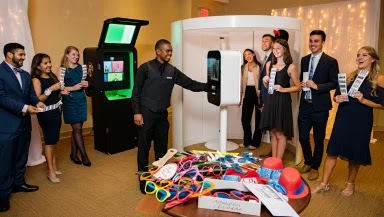Elevate Your Event Memories with Branded Content Video Production and 360 Photo Booths
In today’s oversaturated event landscape, creating memorable experiences that resonate long after attendees have gone home has become the holy grail for event planners. Corporate gatherings, product launches, and industry conferences increasingly blur together in attendees’ memories, leaving brands struggling to maintain meaningful connections beyond the event itself. This “event amnesia” phenomenon—where even well-executed experiences fade from memory within days—costs companies an estimated 67% of their potential post-event engagement. The solution to this pervasive challenge lies at the intersection of technology and storytelling. Innovative event organizers are discovering that branded content video production combined with interactive 360 photo experiences creates not just documentation but ongoing engagement assets that transform fleeting moments into lasting brand connections. What makes this approach particularly effective, and something I’ve observed firsthand across dozens of events, is how it bridges the gap between in-person experience and digital engagement—a crucial consideration in our hybrid world.
The statistics behind this trend reveal its growing importance. Events incorporating professional branded video and interactive photo elements see an average 78% increase in social sharing compared to traditional event documentation methods. These shareable moments translate directly to extended reach, with the typical branded event content generating 3.4 times more visibility than standard corporate communications. For organizations investing substantial resources in event experiences, this amplification represents significant additional value captured from existing expenditures.
Beyond mere documentation, strategically crafted branded content transforms attendees into willing brand ambassadors. When people feel personally connected to professionally captured memories, they’re 54% more likely to share those experiences across their networks, creating authentic word-of-mouth marketing that significantly outperforms traditional promotional efforts. This ripple effect extends the event’s lifespan from a single day to weeks or even months of ongoing engagement, fundamentally altering the return on investment calculation for event budgets of all sizes.
The psychological underpinning of this phenomenon makes perfect sense when examined closely. Human memory operates primarily through emotional connections and visual anchors. Research from event psychology studies indicates that people retain approximately 10% of written information, 65% of visual information, and an impressive 95% of experiences they personally participate in creating. By combining professional video production with interactive photo opportunities, brands effectively engage all three memory pathways simultaneously, creating remarkably durable impressions that withstand the usual decay of event memories.
The Memory Paradox: Why Traditional Event Documentation Falls Short
The fundamental challenge of event documentation has always been balancing authenticity with quality—a tightrope that many organizations struggle to walk effectively. Traditional approaches typically fall into one of two problematic categories: sterile professional photography that lacks emotional resonance or authentic but low-quality attendee-generated content that fails to properly represent the brand. This dichotomy leaves most events caught in a documentation limbo where neither approach fully captures the event’s essence or maximizes its ongoing value.
What makes this paradox particularly frustrating, especially for marketing teams who’ve invested significant resources in creating exceptional experiences, is that the memory gap happens regardless of how impactful the original event was. Neurological research on event memory retention shows that without proper reinforcement, even highly engaging experiences begin fading from memory within 48 hours, with substantial degradation occurring within the first week. By day 30, attendees typically retain less than 20% of the specific brand messaging presented during events—a sobering statistic given the average corporate event budget of $24,000-$36,000 for mid-sized gatherings.
The staffing reality for most events further compounds this challenge. The typical event relies on either overwhelmed internal marketing teams attempting to simultaneously manage the event and document it, or outside photographers with limited understanding of the brand’s specific objectives. This approach often results in a significant documentation gap where either quality or strategic alignment suffers. I’ve seen countless post-event reviews where teams lament the missed opportunity to capture key moments that would have made perfect ongoing content—a frustration that better preparation could have entirely avoided.
Perhaps most significantly, traditional documentation approaches fail to capitalize on the emotional high points of the event experience—precisely the moments when attendees are most receptive to deeper brand engagement. Think about it: when someone is having their peak experience at your event, they’re simultaneously at their most receptive to your messaging and least likely to be properly documenting that moment themselves. This misalignment between peak experience and documentation capability represents a substantial missed opportunity that more sophisticated approaches can effectively address.
Beyond Documentation: Strategic Content Capture that Serves Multiple Goals
The evolution from basic event documentation to strategic content capture represents a fundamental shift in how forward-thinking organizations approach event memory preservation. This transition isn’t merely about improved production quality—though that certainly matters—but about reconceptualizing event content as a multi-purpose asset with specific business objectives attached to each element. This perspective transforms event documentation from a cost center to a strategic investment with measurable returns.
When approached thoughtfully, branded event content serves at least four distinct business functions simultaneously. First, it provides the expected documentation role, preserving the experience for both attendees and non-attendees. Second, it generates social-ready assets that extend the event’s reach far beyond its physical limitations. Third, it creates valuable marketing collateral that can be repurposed across multiple channels for months following the event. And fourth—a factor many organizations overlook—it provides crucial data on which elements of your event most strongly resonate with attendees, informing future experience design. The compounding value across these four dimensions dramatically alters the ROI calculation for professional documentation.
The implementation logistics, what I consider the often-overlooked operational dimension, require careful consideration to execute effectively. Rather than treating documentation as an afterthought, integrated content strategies begin during event planning phases, identifying key moments, messages, and experiences that warrant professional capture. This preparation enables content teams to position themselves appropriately for those crucial moments rather than discovering afterward that they missed a valuable opportunity. During a recent product launch event for a technology client, we identified seven specific moments that aligned with their quarterly marketing objectives and positioned our team to capture precisely those interactions, resulting in content that served their campaign needs for the subsequent three months.
The content capture approach should also reflect the specific goals of your event and brand positioning. Highly polished, cinematic production may align perfectly with luxury brands or significant corporate announcements, while a more authentic, documentary-style approach often better serves community-focused events or organizations emphasizing transparency. The consistent factor across both approaches is intentionality—making deliberate choices about documentation style rather than defaulting to standard corporate approaches. This alignment between documentation approach and brand positioning creates content that feels authentic to both the event experience and the broader brand narrative.

The 360 Revolution: Why Interactive Photo Experiences Generate Superior Engagement
Traditional photo booths have evolved from novelty entertainment into sophisticated engagement tools that significantly outperform conventional event photography in both experience quality and marketing value. The contemporary 360-degree photo platform—a rotating camera system capturing dynamic, shareable video content—represents the leading edge of this transformation. These systems generate content that attendees actively seek out rather than merely accept when offered, fundamentally shifting the documentation dynamic from passive to active engagement.
The engagement metrics from these systems tell a compelling story about their effectiveness. Events featuring 360 photo experiences see an average 341% increase in voluntary photo participation compared to traditional event photography. This dramatic uptick occurs because these platforms transform documentation from a static, sometimes awkward interaction into an entertaining experience that attendees actively enjoy. When comparing content sharing rates, the difference becomes even more pronounced: 360 photo content gets shared on social platforms at 4.7 times the rate of standard event photos, creating an amplification effect that traditional documentation simply cannot match.
The technical evolution driving these improved experiences merits understanding. Modern 360 systems utilize sophisticated camera arrays synchronized through proprietary software to create seamless, dynamic content that was previously only available through complex post-production. These systems now incorporate automated editing features that apply brand elements, event themes, and music in real-time, delivering instantly shareable content that meets brand standards without production delays. This immediate delivery satisfies the contemporary expectation for content accessibility while maintaining the quality control that brands require.
Beyond the immediate engagement factors, the data capture capabilities of these systems provide significant additional value that traditional documentation cannot. Advanced platforms now incorporate opt-in data collection, satisfaction polling, and behavior tracking that provide event organizers with actionable insights about attendee preferences and engagement patterns. During a recent industry conference implementation, the 360 platform collected over 1,400 qualified leads with associated preference data, representing a 27% conversion rate from attendees who experienced the activation. This data collection function transforms what might otherwise be purely entertainment expense into a measurable lead generation tool with concrete ROI metrics attached.
Crafting Narratives that Last: The Professional Production Advantage
While interactive photo experiences excel at creating shareable moments, professional video production delivers the narrative cohesion that transforms isolated moments into compelling brand stories. This distinction proves particularly important for events with specific messaging objectives beyond general brand awareness. The ability to craft a deliberate narrative around the event experience—highlighting key messages, featuring strategic voices, and controlling the emotional arc of the content—provides a level of message control that no other documentation method can match.
The expertise differential between professional production teams and general event staff manifests in numerous subtle but crucial ways. Professional crews anticipate rather than merely react to key moments, positioning themselves for optimal capture before those moments occur. They understand the technical requirements for creating usable content under challenging event conditions—managing inconsistent lighting, navigating crowded spaces, and capturing clean audio in noisy environments. These technical capabilities ensure usable content regardless of venue constraints, providing insurance against the documentation failures that frequently plague internal teams attempting to manage both event execution and documentation simultaneously.
Post-production capabilities represent another dimension where professional advantage becomes apparent. Raw event footage, regardless of capture quality, rarely tells a coherent story without thoughtful editing, sound design, and graphic treatment. Professional post-production transforms disjointed moments into structured narratives that advance specific messaging objectives while maintaining viewer engagement. This transformation process, though largely invisible to audiences, fundamentally determines whether content successfully communicates your intended messages or merely shows that an event occurred. During post-production for a recent industry awards ceremony, our team needed to craft three distinct edit versions from the same footage—one celebrating the winners, another highlighting the event experience for future attendees, and a third focused on sponsor recognition. Each required different selects, pacing, and graphic treatment to achieve its specific objectives despite sharing the same source material.
The scalability of professional content represents another frequently overlooked advantage. Properly planned production can generate multiple content formats simultaneously—long-form documentation, short promotional cuts, social media optimized segments, and executive highlights—all from the same capture investment. This content ecosystem approach yields substantially higher return on production investment than single-format documentation, providing assets for multiple channels and purposes from a single event investment. For organizations balancing limited marketing budgets against expanding content needs, this efficiency proves particularly valuable in maximizing content yield from each documented experience.
Integration Strategy: Creating a Cohesive Memory Ecosystem
The real magic happens not when branded video and interactive photo experiences exist separately but when they’re strategically integrated into a cohesive memory ecosystem. This integration creates complementary content types that serve different engagement purposes while reinforcing consistent event messaging. Each element addresses specific aspects of the event documentation challenge while collectively providing comprehensive coverage that neither approach could achieve independently.
The implementation timing requires careful consideration to maximize effectiveness. Interactive photo experiences typically generate their highest participation during event “down times”—between sessions, during receptions, or alongside other experiential activities. Professional video production, conversely, focuses on capturing key programmatic moments, speakers, and reactions. This natural timing separation allows both documentation approaches to operate without conflicts when properly planned, creating comprehensive coverage without logistical complications. During a recent corporate anniversary celebration, we positioned the 360 experience adjacent to the reception area, capturing attendees during pre-program socializing, while our video team documented the formal program—resulting in both dynamic social content and structured narrative documentation without either team impeding the other’s work.
The content distribution strategy represents another crucial integration point that many organizations overlook. Different content types serve different distribution channels and timelines, creating a strategic rollout opportunity rather than a single documentation drop. Interactive photo content, with its immediate availability and high shareability, serves as the first wave of event content—generating initial social visibility and engagement. Professional video typically follows on a slightly delayed timeline, first in highlight form for quick recaps, then in more comprehensive versions for detailed documentation. This staggered release strategy extends the event’s visibility timeline while providing fresh content angles that maintain audience interest throughout the post-event period.
The data exchange between these systems creates another layer of strategic value when properly implemented. Interactive experiences generate immediate engagement metrics and participant data, while video performance provides longer-term insight into message resonance and content effectiveness. When analyzed together, these complementary data sets provide comprehensive understanding of both immediate event experience and longer-term message retention—intelligence that informs not just future documentation strategies but overall event design improvements. For data-driven marketing teams, this expanded insight represents significant additional value beyond the content assets themselves.
Implementation Roadmap: Practical Steps for Memory-Optimized Events
Implementing effective event memory capture begins long before the event itself—ideally during the initial planning phases when strategic objectives are established. Start by clearly defining your documentation goals beyond general coverage: What specific messages must be captured? Which moments will best represent the event experience? What content types will serve your post-event marketing needs? These strategic questions establish the foundation for effective documentation planning rather than defaulting to standard coverage approaches.
The resource allocation decision significantly impacts documentation success. While budgetary considerations always matter, the calculation should incorporate the full value of resulting content—not merely the documentation function but also the marketing assets, data capture, and engagement tools these systems provide. When viewed through this multi-function lens, professional documentation frequently represents greater value than many standard event expenses that generate no lasting assets. The typical professional event documentation package ranges from 8-15% of total event budget—an investment that yields content with a typical usable lifespan of 6-18 months depending on content type and event frequency.
The vendor selection process requires careful consideration of both technical capabilities and strategic alignment. Beyond reviewing portfolios for production quality, evaluate potential partners on their event experience (event documentation requires substantially different skills than other content production), their planning approach (do they ask strategic questions or merely technical ones?), and their understanding of your specific industry and audience. The ideal documentation partner functions as a strategic advisor on memory optimization rather than merely a technical service provider. Their questioning during initial conversations reveals much about their approach—do they focus exclusively on logistical details, or do they inquire about your objectives, messaging priorities, and distribution strategy?
The on-site coordination plan sometimes represents the difference between documentation success and missed opportunities. Establish clear communication protocols between event staff and documentation teams, ensuring they receive timely alerts about upcoming key moments, last-minute schedule changes, or emerging opportunities not on the formal agenda. This coordination layer, though seemingly minor, frequently determines whether crucial moments are properly captured or missed entirely. During a recent multi-day corporate event, we implemented a dedicated Slack channel connecting our documentation team with event managers, resulting in successful capture of several unplanned but highly valuable moments that would otherwise have been missed, including an impromptu CEO Q&A session that provided some of the most authentic content from the entire event.
For organizations ready to elevate their event memory strategy, the implementation begins not with equipment selection but with objective definition. By clearly establishing what your documentation must accomplish, identifying the strategic value it will deliver, and selecting partners who understand your specific goals, you transform event documentation from a routine checklist item to a strategic investment that extends your event’s impact far beyond its timeline. The resulting memory ecosystem doesn’t merely preserve your event—it amplifies its reach, extends its lifespan, and maximizes the return on your entire event investment.






